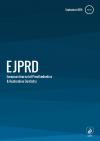European Journal of Prosthodontics and Restorative Dentistry
Clinical Evaluation of Three Types of CAD/CAM Inlay/ Onlay Materials After 1-Year Clinical Follow Up
Abstract
European Journal of Prosthodontics and Restorative Dentistry (2019) 27, 131–140
Clinical Evaluation of Three
Types of Cad/Cam Inlay/
Onlay Materials After 1-Year
Clinical Follow Up
Keywords
SEM
Clinical Evaluation
CAD/CAM
Lithium Disilicate Ceramics
CAD CAM Resin Composite
Authors
Dr. Yılmaz Umut Aslan*
(Assist Prof, PhD)
Dr. Elif Coskun*
(PhD)
Prof. Yasemin Ozkan*
(Prof Dr, PhD)
Prof. Michel Dard§
(DDS, Ms, PhD)
Address for Correspondence
Prof. Yasemin Ozkan
Email: [email protected]
* University of Marmara, Faculty of Dentistry,
Department of Prosthodontics
University of Columbia, College of Dental
Medicine, Section of Oral, Diagnostic and
Rehabilitation Sciences, New York, USA and
Global Medical Director , Straumann Group
§
ABSTRACT
Objective: To evaluate the clinical performance and the marginal adaptation of inlay/
onlay restorations made of lithium of a new lithium disilicate strengthened, lithium alumino-silicate glass-ceramic (LAS) material compared with a conventional lithium-disilicate
glass-ceramic (LDS) and new-generation polymer-based CAD/CAM resin composite (CS)
materials over one year. Materials and Methods: Seventy-five inlay-onlay restorations were
placed in 35 patients. The restorations were assigned and randomized to three groups as
LDS, LAS, and CS. Clinical evaluations were performed after one week, six months, and
one year after the cementation, according to the modified United States Public Health
Services (USPHS) criteria. The marginal quality analyses of 21 samples (n=7) were assessed under a scanning electron microscope. The data were analyzed by using Friedman,
Wilcoxon Signed Ranks, Chi-square and Paired t-tests (p<0.05). Results: No statistically
significant difference (p>0.05) was found between groups in the modified USPHS, gingival
index, and plaque index evaluations, and the total success rate was 100% for three groups
after one year. Following SEM evaluations in all groups, continuous margin percentages
were decreased, but these results were not statistically significant (p>0.05). Conclusions:
Lithium disilicate-strengthened lithium aluminosilicate glass-ceramics can be considered
a reliable material for an option for posterior onlay/inlay restorations.
INTRODUCTION
There has been a rapid evolution of restorative materials in digital dentistry over the last decade.1-4 All-ceramic inlays and onlays have become
popular in restorative dentistry due to their high aesthetic quality, durability, wear resistance, color stability, biocompatibility, and conservative
treatment, with high long-term survival rates.5-9 Development with of
CAD-CAM technology is now commonly used for the fabrication of indirect esthetic restorations, and ceramic restorations can be manufactured
in a single appointment. The impressions are taken with digital intraoral
scanners and transferred directly to the milling device. Thus, the workflow chain is accelerated, and the process errors arising from impressiontaking and model fabrication are eliminated.10 Several chairside CAD/CAM
ceramic blocks have been commonly used for this purpose in routine
clinical practice.11-17 There are several ways to classify dental ceramics, including clinical indications, composition, microstructure, etching, processing methods, firing temperatures, translucency, fracture resistance and
antagonist wear.1-3,11 On the other hand, new restorative materials that
have recently been launched in the dental market are not easily classi-
Received: 18.12.2018
Accepted: 31.07.2019
doi: 10.1922/EJPRD_01891Aslan10
• • • • • • • • • • • • • • • • • • • • • • • • • • • • • • • •
ejprd.org - Published by Dennis Barber Journals.
EJPRD
Copyright ©2019 by Dennis Barber Ltd. All rights reserved.
Authors
Dr. Yılmaz Umut Aslan, Dr. Elif Coskun, Prof. Yasemin Ozkan, Prof. Michel Dard
Articles from this issue
| Title / DOI | Access | Page Start | Page End | Purchase |
|---|---|---|---|---|
| Evaluation of Smear Layer Removal Using Different Irrigation Methods In Root Canals 10.1922/EJPRD_01817Husain06 |
|
97 | 102 |
£10.00 |
| Longevity of Bond Strength of an Indirect Composite Resin to Dentin Using Conventional or Self-Adhesive Resin Cementation: Influence of Dentin Pretreatment with TiF4 10.1922/EJPRD_01907Viana10 |
|
103 | 112 |
£10.00 |
| PEEK High Performance Polymers: A Review of Properties and Clinical Applications in Prosthodontics and Restorative Dentistry 10.1922/EJPRD_01892Zoidis09 |
|
113 | 121 |
£10.00 |
| Accuracy of IOS in Full-Arch Dentate Patients Compared to CBCT Cast-Scanning. An In-Vivo Study 10.1922/EJPRD_01906Michelinakis09 |
|
122 | 130 |
£10.00 |
| Clinical Evaluation of Three Types of CAD/CAM Inlay/ Onlay Materials After 1-Year Clinical Follow Up |
|
131 | 140 |
£10.00 |
 Free Access
Free Access No Access
No Access Full Access
Full Access


